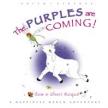Gods Creatures on the March
A good book is hard to find. It is a doubly rare treat to find one worth reading aloud to your children. As a father of four boys, three of whom have reached the ages of heavy book consumption (nine, five and three), I have plodded through my share of disappointing children’s books, cringing every time my child reaches for The Berenstain Bears, or the latest installment in the Franklin series, gratefully smiling when they turn instead to the old-school Beatrix Potter or Winnie the Pooh.
And so it was with cautious trepidation that I first cracked open The Purples Are Coming! To my relief, I was not disappointed. Here is a children’s picture book that breaks the mold—delightfully. The husband and wife team Ilow and Sheri Roque have apparently cast aside today’s publishing industry conventions to produce a book that both children and the grownups who read to them can enjoy. The use of poetic verse, not so unusual among children’s books, avoids the heavy-handed rhyme scheme and tedious cadence that render many modern children’s books oppressive to the ear. In the realm of vocabulary, we are treated to “crimson” rather than “red,” and “dappled” in place of “spotted.” (It feels a bit like Gerard Manley Hopkins for 6-year-olds: “Glory be to God for dappled things…”). Birds are of multiple species—characters include “wrens” and “kingfishers,” rather than the more familiar and pedestrian pigeons and crows that typically populate the genre.
How often do we encounter lines like the following in contemporary children’s literature: “The three of them stood there, Bella, Derdle, and Dink...stacked one on top of the other just like one lamb, one kingfisher, and one wren might stack, you would think.”
Unlike the prose of some children’s books, Purples has a spritely, imaginative style. We get a wink and a nod, for who has the slightest idea (assuming first that one knows what these animals are) how they might stack? But of course, that’s precisely the point. And as for the forward-leaning vocabulary, I am reminded of the oft-quoted publishing rules dictated by the children’s literary cognoscenti: “Never use words that a 6-year-old might not know”—forgetting that 6-year-olds daily encounter novel words without seeming to display any bewilderment. They would not ask you to open a dictionary; literary context is all they typically require. New words—insofar as their novelty even registers to the first grader—will delight the child, as does anything new.
But more important, this is a story worth reading. It is a tale of friendship and spiritual insight that introduces the reader to a troupe of comrades on a journey of hope and anticipation. I am reminded of Pope Benedict XVI’s admonition that “life is not just a succession of events, it is a search for the true, the good, and the beautiful.” Only in encountering these transcendental attributes do we find happiness. And so it is with this tale. As the journey proceeds, the original cast is joined on their “happiness march” by others, who likewise are eager to see the “purples”—dazzling fields of new flowers in bloom. The amusing names did not fail to escape comment from my 5- and 9-year-olds, who saw the humor in Ladislaus Molski (the educated mole concerned about his failing eyesight) and Hubert Epineux (the spiritually ambitious hedgehog who uses stilts to get closer to God). They were also amused by the peculiar (perhaps neurotic) idiosyncrasies of Gracie O’Hare, a nervous, fretful rabbit. The friends are bound together by the hope of the journey, and by their shared faith and piety.
All modern children’s books are evangelical, in the sense that they preach a gospel of sorts. The gospels of diversity or of environmentalism seem to be especially favored these days. More pedantic exercises in preaching—”do your homework,” or “tell the truth”—also characterize numerous books within children’s literature. Religious books (including Christian ones) also abound, though most are stocked in strictly Christian bookstores or relegated to the “religion” section of secular stores. The safe bets are usually retellings of Bible stories, which offer countless variations on Noah’s Ark or the Nativity story. These are important, of course, but equally important is the availability of a variety of reading options.
Stories of pilgrims on a journey reflect the lives of ordinary Christians and remind us of our status in this world. Indeed, the greatest merit of The Purples Are Coming! is its celebration of ordinary life—which for all its everydayness, can still be understood as a divine adventure. The group of friends is introduced to the thrilling notion that even they (with all their frailties and follies) can be apostles of prayer. (Dink hears the message as “popsicles of prayer,” but is given a gentle and amused fraternal correction.) Ordinary life, and an ordinary journey, is the setting for these Christians to live out their faith and hope, and to practice a charity rooted in friendship and confidence.
All this is refreshingly conveyed without the least trace of preachiness or pious condescension. Eye-catching, colorful and lively illustrations complement the verse: memorable characters sparkle in the foreground, against a soft backdrop of rolling fields and wildflowers.
Youngsters will thoroughly enjoy following this adventurous journey, while seeing how God’s grace suffuses nature’s beauty.
This article also appeared in print, under the headline “Gods Creatures on the March,” in the March 15, 2010, issue.








